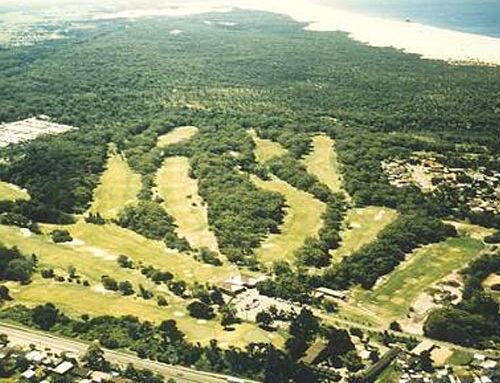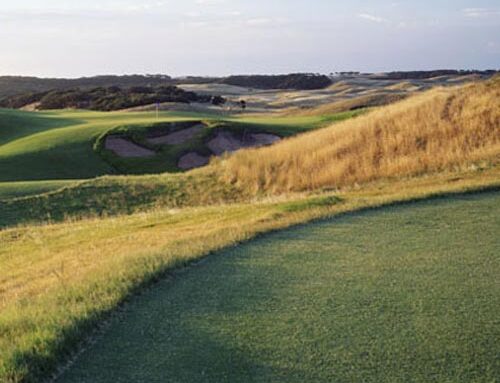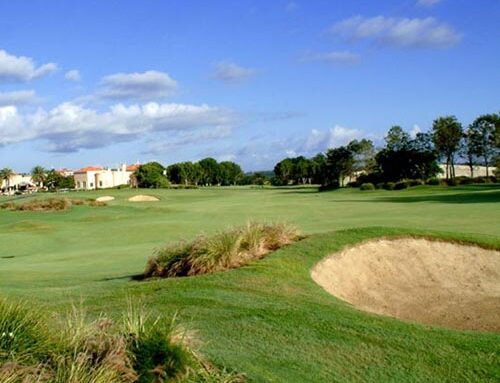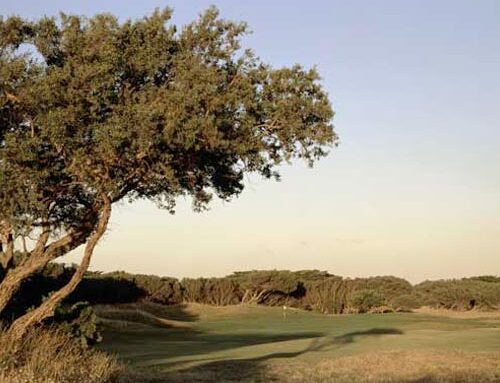Barnbougle Dunes
Tasmania, AUSTRALIA
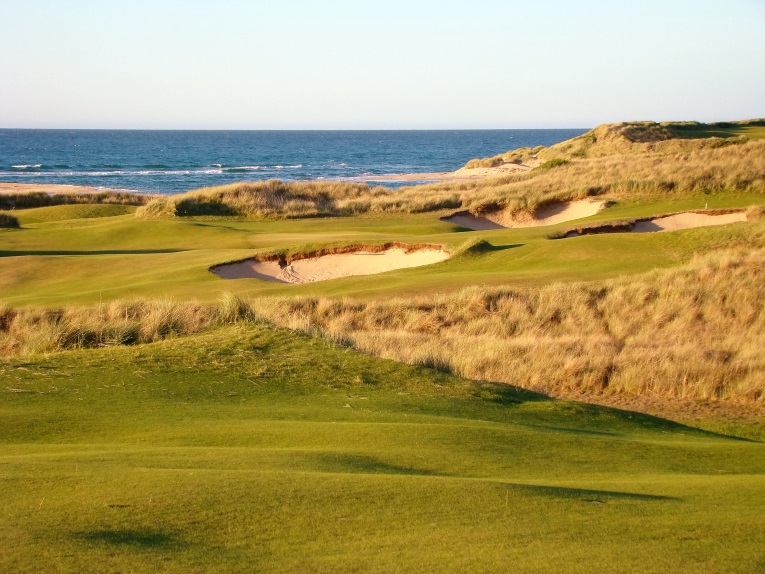
This northerly view across the narrow dunescape of Barnbougle Dunes reveals land poorly-suited for potato farming but supreme (!) for golf.
Golf’s most cherished form is played on linksland, where the game originated. Its combination of fast running turf, sandy soils and wind-shaped terrain is irresistible. Yet, the opportunity to work with such land is rare and most modern architects must content themselves with the ersatz, faux links.
In Tom Doak’s portfolio the one course unequivocally set on linksland is Barnbougle Dunes. Plenty of his other sites – inland Ballyneal, clifftop Pacific Dunes and Cape Kidnappers have their own attributes – but by the strictest definition, only Barnbougle Dunes is 100% pure links. All the contours were there and by modern golf architecture standards only teaspoons of earth were moved in its creation.
How the course came to fruition is interesting. When Australian Greg Ramsay was in his early 20s, he traveled around Tasmania to prepare a detailed report for the island’s government on how its golf offerings could be improved. As government is prone to do the report was ignored.
Yet, the intrepid Ramsay had identified a superb strip of dunesland that stretched 3,000 metres along the Tasman Sea. He approached Richard Sattler, the owner of the land, about building a golf course and simultaneously contacted Tom Doak and Australian professional golfer and architect Mike Clayton. A remarkably successful potato farmer, Sattler knew that the dunes were of little use for farming but the idea of golf seemed a stretch. Nonetheless, he gave Ramsay an option on the property and Ramsay set about to try to bring the course to fruition.
Initially, Bruce Hepner from Doak’s office toured the property with Clayton. Wonderful landforms for golf abounded making the site’s potential clear. What was murkier was how to finance such a project. Enter golf’s magic man for remote settings, Mike Keiser. Ramsay contacted Keiser, who had just seen his second course (Doak’s Pacific Dunes) at the hugely popular Bandon Dunes Resort open to world top 25 acclaim.
Over Christmas 2002, Keiser and Doak met at Barnbougle to compare notes. A first nine was somewhat self-evident in that golf holes needed to be nestled in the deep valleys that punctuated the landscape in an east/west direction. So narrow are the dunes that any par 4 running north/south would have extended into the neighboring farmland.
Tweaks along the way to the routing included breaking the planned par 5 third into today’s third and fourth holes. This first draft par 5 would have finished behind the awesome blowout bunker now on the fourth but against the prevailing wind was thought too fierce.
Another key piece of the puzzle arose when Clayton suggested pivoting the seventh and sending it in a westerly direction as opposed to the run of holes around it that head east through valleys. This tiny little one shotter plays to an exposed shelf green and as such, made for a distinctly welcome contrast to the other one shotters with their sideboards and punchbowl features. Clayton recalls, ‘I remember standing on what became the 7th tee with Tom and Brian Schneider when Tom asked if we thought it should play toward the beach (at a right angle to what it is). It looked better to both Brian and I heading the way it did – it reversed the direction of holes and playing amid strong crosswinds would have been brutal.’
Initially, co-designers Doak and Clayton had much of the back nine reversed. The tenth played down today’s eighteenth with the beach on the left like the first at Machrihanish. Keiser thought the course needed to end with more punch than an eighteenth playing up today’s comparably flat tenth fairway.
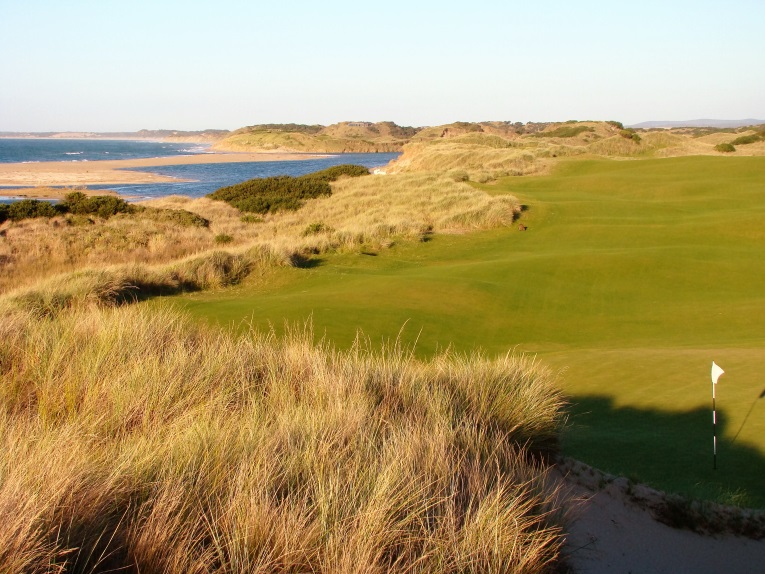
This view from behind the eighteenth highlights two things: why Doak initially routed a par 4 heading easterly with water on the left (Clayton called the would-be hole ‘brilliant’) and why Keiser saw merit in having the Home hole finish in such grand fashion near the beach (Clayton agrees that was ‘absolutely the right call’).
Tom went back for another look around. At first, he had shied away from the low lying area that today’s seventeenth fairway occupies. Watching the wind whip the sand and deposit it into this valley seemed like a battle best avoided. Yet, climbing up a far dune, turning west and visualizing this 400 metre hole to a natural green site was ultimately too compelling. Keiser was equally impressed and convinced Sattler what a truly special piece of ground he had and invited him to Bandon to see how a resort could be run. Sattler bought into the vision, the money was raised and construction began in 2003.
In the end the routing became a classic figure 8 with the clubhouse in the middle. Herbert Fowler demonstrated the merit of such a configuration at Eastward Ho! on Cape Cod in 1922 and Pete Dye popularized it at two of his most noted designs, The Ocean Course at Kiawah and Whistling Straits. Within these loops at Barnbougle the playing corridors regularly shift 15 to 25 degrees from the preceding hole. Such subtle changes in direction make the golfer continually re-calculate the wind’s effect on any given hole/shot.
Doak considers Barnbougle to be the windiest site upon which he has worked. Normally, there is a headwind going out to the fifth tee. Clayton notes, ‘ The prevailing winds were a big consideration during construction. Except for 17 and 18, all the ‘short’ holes play into the normal wind and all the ‘long’ ones play with the wind behind. It works well – but when it does blow the other way (it’s never that strong when it does) 1 (because it’s reachable with two great shots) and 4 are more fun – especially 4 because it gives so many more a chance to take on the bunker and the green. The run of holes 5, 6, 8 (a three shotter when it’s into the wind) 9, 10 and 11 are really strong and fun to play. Downwind, 7 is very difficult but 12 becomes drivable (it would be so much fun to watch really top-class players trying to drive the ball onto that green).’
He goes on, ‘Surprisingly, I’ve found, in a way, the course to be more difficult with no wind. It sounds silly but there is no help on the ‘long’ holes (5, 6, 8, 9, 10, 11, 14) and they play much harder. 5 goes from being a 6 iron with a normal, decent wind to a 2 iron. 6 is a drive and middle iron as are 9 and 10. 8 is brutal and controversial. I like it and Tom would say it’s a hole which clearly demonstrates why Geoff Ogilvy is a much better player than I am. I would have to hit a good drive and a 3 wood but he rips it onto the green with a 6 iron. Holes where I hit a 4 iron and he hits a 9 are less demonstrative. Maybe every course needs a hole like that?’
During construction, Clayton regularly flew in from Melbourne while Brian Schneider, fresh from Cape Kidnappers, lived on site as Doak’s Lead Associate. Talented interns including George Waters, Kyle Franz, Chad Grave, Philippe Binette from Renaissance Golf Design came and went during the project. Ashley Mead ran the project for Clayton and when you add in the skills of Jason McCarthy, the highly talented shaper from Clayton’s firm, there was amassed an unusually gifted set of people. Best of all, these appreciative twenty-something year olds knew that they might never work on such pure linksland ever again – and they were determined to make the most of it.
Throughout the endeavor the camaraderie was excellent and their enjoyment is reflected in the final design. From Schneider’s perspective, Barnbougle Dunes is both his favorite project and course to play. In part, he says with a smile, because many of the holes suit his game. He contends that to call a 300 metre hole ‘drivable’ is a bit silly when most of us don’t hit it past 230 metres. Therefore, a hole like the fourth that requires but a 200 metre carry to “open-up” the punchbowl green is welcoming. Schneider most admires how the hole is ‘…in reach for a broad spectrum of players without necessarily being any easier for the man off scratch.’ As is true at Machrihanish and North Berwick, everyone seems to enjoy the thrill of the shots asked of them at Barnbougle while the tiger never quite seems to score as low as he hopes.
On a return inspection here in February 2016, Schneider was delighted to find that the purity of the fescue (70%) and seaside bent (30%) grassing scheme remains high. He states, ‘the turf has matured beautifully, better than I could have hoped with fescue strongly predominating’ and that means that the course invariably plays firm and running. Schneider places great importance in the fact that you ‘…can’t just pull a wedge and hit to a set distance, you have to play shots around this course.’ We see what he means below.
Holes to Note
First hole, 505 metres; By definition, remote courses require travel and the first swings of the day aren’t guaranteed to be a stiff traveler’s proudest moments. Hence, some of the world’s best remote courses (Sand Hills, The Red Course at Dismal River, Cabot Links, Cabot Cliffs, and here) begin with a par 5. It’s a nice way to edge into a highly anticipated round, even if pace of play experts wince. Besides, Barnbougle is rarely chock-a-block for tee times.
Second hole, 380 metres; The merits of Barnbougle Dunes are straightforward: the highs are high (i.e. world class holes are laced throughout) and lows don’t exist. Some quibble about the first and second holes as they don’t occupy scintillating dune country. Yet, the approach to the second green, especially when the hole is in the back half of the deep green, is among the most vexing shots on the course. Thank goodness the architects didn’t junk up the landscape at the start with silly features. Instead, a trio of low profile fairway bunkers down the left combined with a long, narrow raised green that opens from the left make for an endlessly interesting dilemma. The hole might look effortless – and perhaps simplistic to the undiscerning – but the quality of the golf more than carries the day.
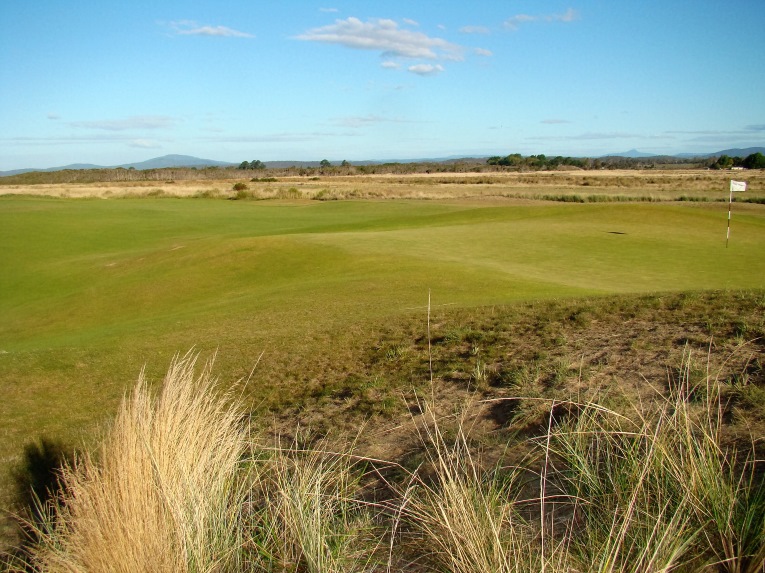
Looking back down the second fairway, one appreciates the green’s placement as well as how flat the land is adjacent to the course.
Third hole, 340 metres; Take a look at the design elements brought to bear here. First, the tee placed high and right in the dunes creates an attractive diagonal carry into the fairway. Second, a 80 metre long natural hog’s back ridge was exploited to perfection down the middle of the fairway. The fairway’s high right side (blind from the tee) is often the preferred spot for one’s tee ball. If the golfer plays “safely” toward the wide, visible fairway left, the ridge shunts his tee ball into an ever disadvantaged position. Third, a magnificent blowout bunker was sculpted on the outside of the dogleg to ‘turn’ the hole right. Fourth, the orientation of the green is toward the right portion of the fairway with one caveat: a wonderful back right hole location that is best accessed from the far left of the fairway. Finally, the green is one of the deepest on the course and of the fallaway variety, meaning it slopes away from the player in the fairway. Time has shown at courses like Yale and St. Andrews that getting a short iron close to a flag on a large target is perversely difficult. So, are we in the dunes? Yes. Is that what makes the hole enduring? No. It’s all those thoughtful architectural elements.
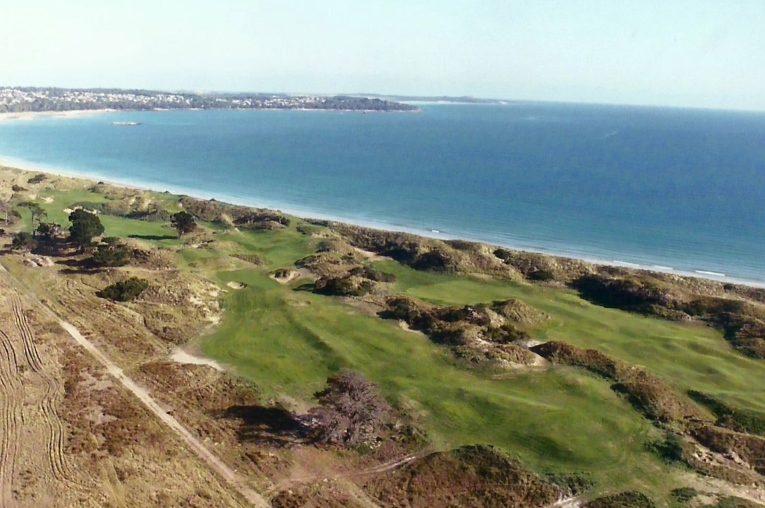
Brian Schneider shares this photograph from an ultra-light toward the end of grow-in: the third hole is low center and some of its attributes noted above are evident.
Fourth hole, 270 metres; Barnbougle Dunes showcases several distinctive short par 4s. This one is of the drivable genre and because the green is located in a natural punchbowl, there are countless ways for a tee ball to be gathered down onto the putting surface. A golfer is rightly irritated when conditions permit if he doesn’t take a mighty swipe at the green from the tee. Of course, to create the proper tension between architect and player, a downside for a failed attempt must exist. Indeed, the deepest blowout bunker on the course is on a direct line from tee to green as well as a pair of other bunkers on the farther dune. All three are hazards in the truest sense to be avoided. Doak recalls, ‘I will never forget the day I went out to flag the bunkers for #4. The big one to the right of the fairway was a natural blowout, but I was worried about people losing balls in the marram grass on their pitch shots, so I decided to add the two on the dune short left of the green … there are quite a few bunkers at Barnbougle which were added for that reason, as we were on a tight budget and didn’t have the money for a lot of extra irrigated turf. The combined effect of the three bunkers, each smaller than the last, took me by surprise, but it was then I realized how special the hole was going to be.’
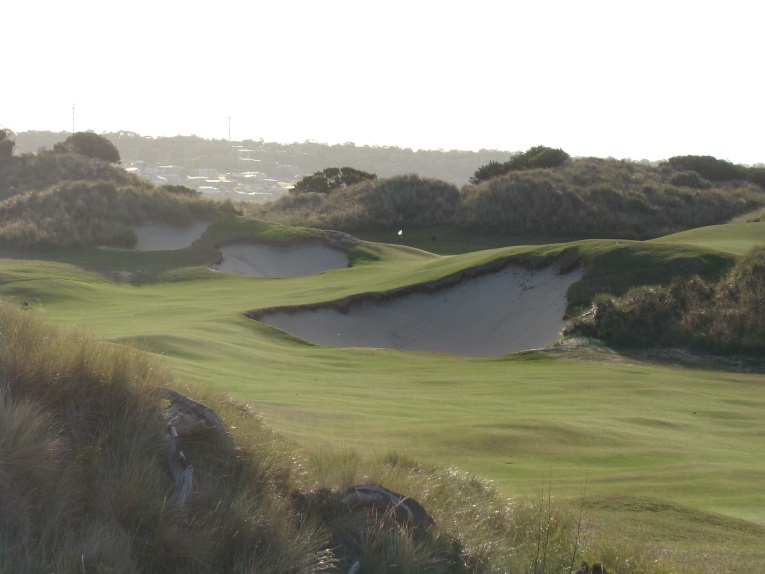
One of the game’s elite short two shotters: the fourth at Barnbougle Dunes. Carry the crest of the dune in the foreground and the golfer may well be rewarded with a putt for eagle.
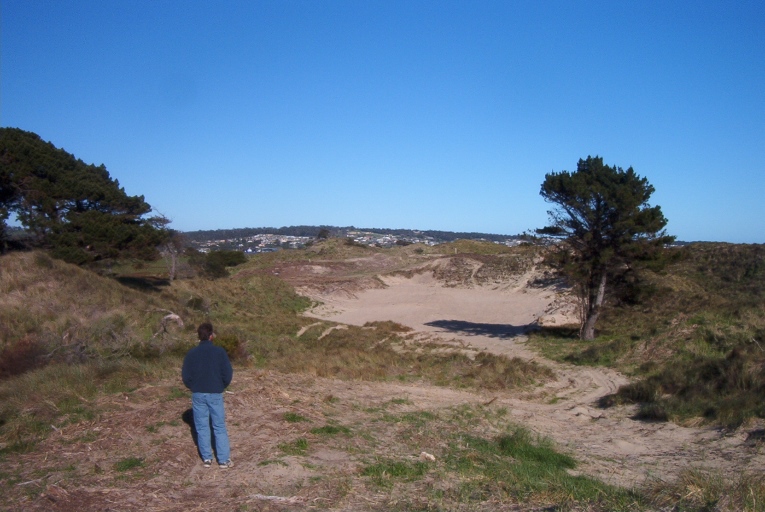
Fourteen years prior, here is the view looking down what became the fourth; all the primary landforms and features highlighted in the photograph one above were there!
Fifth hole, 200 metres; The golfer turns toward the clubhouse and plays easterly for eight of the next ten holes. Hunkered down in its own valley, this green complex accepts a wide variety of shots. What the author particularly admires is that there is no clear delineation between the tight fescue playing surface surrounding the green and the putting surface. The fescues blend harmoniously and constitute one massive playing surface snuggled in the dunes. In this elevated form of golf, the spot for one’s ball to land isn’t the green itself but its surrounds. Inventiveness and imagination soar when compared to the deadly dull brand of point-to-point golf where the ball lands with a splat on a soft surface.
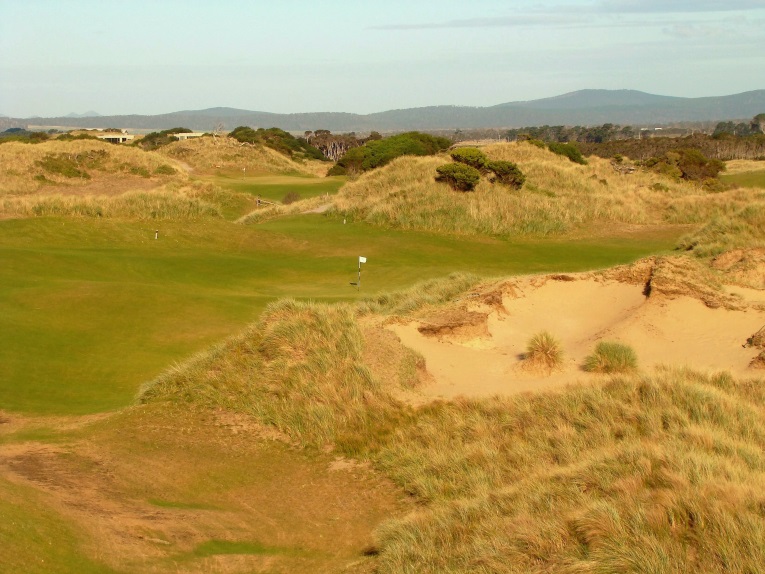
Downwind, the side and back banks around the green can be used to brake the ball and feed it toward the hole.
Sixth hole, 380 metres; Holes can look good and sometimes play as well as they look. This wild and wooly one is a natural, played through a valley to a green high on a dune. In truth the dunes might actually be a bit too big but what a good problem for the architects to have to overcome. Conflict is created by a dune’s shoulder that protrudes from the right as it compromises the golfer’s desire to approach the green from that side. As the player edges left, his angle of approach progressively worsens due to the green’s left to right tilt and steep right bank with tight fescue that shunts balls away.
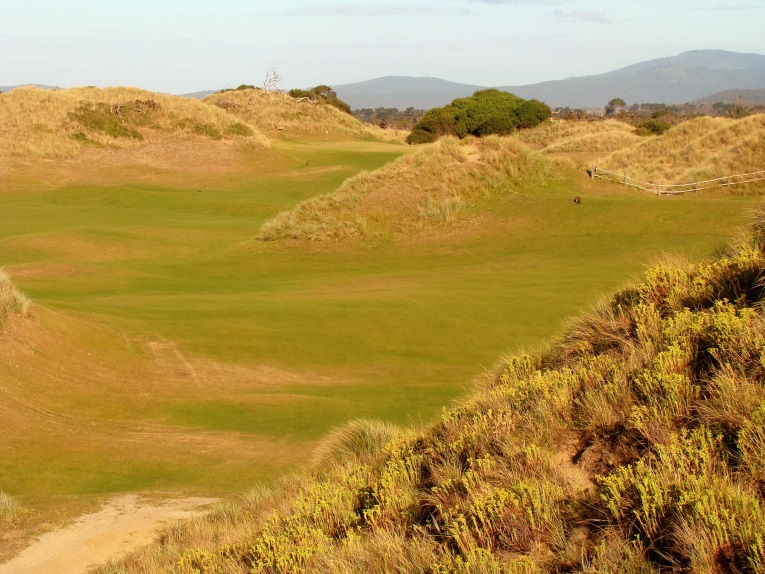
The view from the sixth tee. No course in the famed Melbourne sandbelt can compete with Barnbougle for topographic interest.
Seventh hole, 110 metres; Evil incarnate, this little monster deserves its place beside other card wrecking short one-shotters like the seventh at Pebble Beach and County Down and the famous Postage Stamp at Troon. Under equal wind conditions, it would be fascinating to see which of this quartet would play the hardest for the tiger. This green is wider than a couple of those … but that’s the sole comfort. All four frequently play in the wind, which amps up the misery index. To say that instant death greets a ball left or long is wishful thinking as recovery generally turns into protracted agony. Not dissimilar to the twelfth at Augusta National, there is relief when the golfer puts this outstanding hole in his rear view mirror. Doak gives Clayton gobs of credit for envisioning this hole and it joins the fourth and thirteenth as Tom’s three favorites on the course.
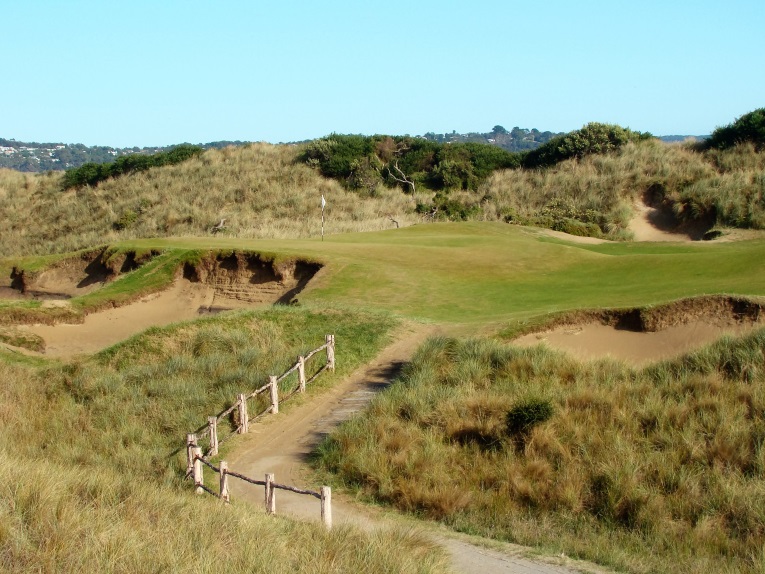
Even on this calm morning, the time to celebrate is after you hit the green. It is the single most important shot on the course to get right, which of course doesn’t help!
Eighth hole, 445 metres; No doubt this hole has the ‘fair police’ gnashing their teeth. It is the longest two shotter on the course AND plays over the most raucous, tumbling land. Split into an upper and lower fairway, the upper left side is the more direct route home but the lower one is wider and provides more level stances. What to do? There is no clear answer, which is quite refreshing. Like the Old Course at St. Andrews, the golfer is always left after each round with a few shots to mull over that he might tactically play different the next time.

High left is shorter but low right is safer. Note the alluring colors (plural!) of the fairways in the late afternoon sun; Tasmania enjoys a cooler climate than the mainland, making it ideal for fescue. The grasses bake some in summer but rarely too much.
Ninth hole, 400 metres; Fescue fairways are a luxury for a skilled architect. Downwind, such fairways can be used to help the golfer (e.g. the eleventh hole where a well struck tee ball receives a boost forward and brings the green within reach) or hurt him (e.g. here where a diagonal drop in the fairway propels long tee balls farther right (and out of position) from where several deep bunkers must be carried on the approach). Clayton writes, ‘The fescue makes it the only course (later, Lost Farm and Cape Wickham) using the proper grass for golf. Here, the feel of club on turf and ball is unmatched in Australia where almost all the golf is on bermuda or kikuyu. People often complain about the condition because they are so used to fairways they consider perfect at Kingston Heath and Metropolitan. IMO, they don’t understand how much better the club, ball contact is from fescue. And, of course, there is ‘perfect turf’ and turf that is perfect for golf. Barnbougle (and Lost Farm) feature the perfect turf for golf – and IMO make them the best conditioned courses in the country because it allows for the best form of playing the game. Hitting an iron 40 yards short and left of the 9th green and watching it feed all the way around the hill and onto the green is so much fun.’
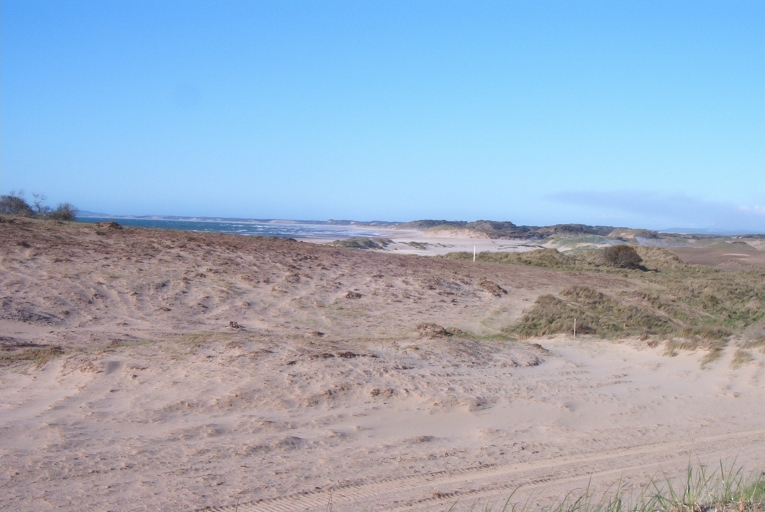
Eric Iverson, who came along for one guest shaping visit, built the greens for the 7th, 8th and the top-notch fallaway 9th, staked out above. At one point, Tom had it as a one shotter and adamantly retained the approach throughout all iterations.
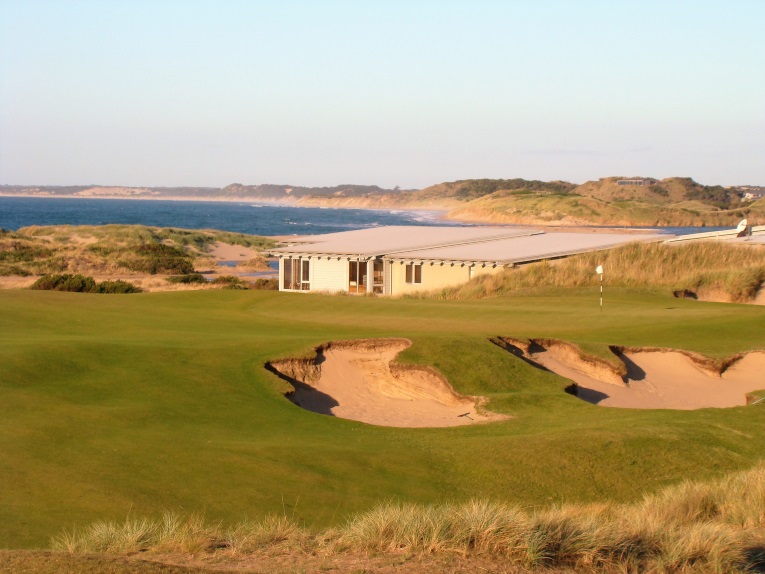
The golfer much prefers to stay high and left off the tee so that his approach can bounce onto the fallaway green versus having to flirt with the fierce right greenside bunker. The view from above is from a tee ball that ran too far. Tom remembers, ‘I begged Richard Sattler to keep the clubhouse small, to preserve the beach view, and just have a big deck out in back of it; but the place got so busy that by Year Two, the clubhouse expanded and my view was gone. Richard always apologizes to me about that when I go back to Barnbougle, but he is always laughing when he does so.’
Tenth hole, 410 metres; After the perils of the last several holes, the tenth’s warm inviting nature is a welcome sight. The spacious fairway encourages a bold free swing as does the elevated green, which is the most loosely guarded on the course as the large, handsome bunkers are well removed from the convoluted putting surface. Hitting the fairway and the green in regulation are not the same as getting a par; lots of three putt bogeys occur here. How Brian Schneider got the putting surface to drip down the hillside is the hole’s most impressive attribute.

The massive blowout bunker to the left of the tenth green was one of the first bunkers built. Suffice to say, everyone liked what emerged and knew what to strive for stylistically.

Note how the putting green cascades down the dune. Using the side board right is preferable for accessing the day’s hole location to trying to tip-toe past the wicked false front.
Eleventh hole, 475 metres; Barnbougle Dunes was conceived in the early 2000s when most courses featured narrow fairways that precluded fun, option-filled golf. Over the ensuing fifteen years, things have changed but the pendulum may have swung too far; some holes are nothing more than a bomber’s paradise where mindless brute strength trumps precision and craftiness. On the surface, this reachable par 5 with its wide, friendly fairway seemingly falls into that category but trial and error shows there is much too admire here. Happily, the hole is often downwind and a manageable alley feeds onto the green’s right center. However, miss it a bit to the right and your approach – forlornly – curls away into the deepest greenside bunker on the course, leaving that wildly unpopular 40 metre long explosion. More irritating is how the left bank of the green works in perfect concert with that side’s less intimidating greenside bunkers. This terror is more subtle than the right but the effect is similar: the golfer leaves the hole wondering what in the heck went wrong.

As seen from 200 metres away, a slightly pushed ball peels right to be unceremoniously deposited into a sandy pit. Conversely, finding and utilizing the alleyway onto the green is one of the most rewarding – and precise – shots found on the course.
Twelfth hole, 255 metres; One nice aspect about the twelfth is how well it fits into the Barnbougle experience. No one comes here for just one round. During your stay, you can experiment off the tee in the various winds with driver, three wood, hybrid and even midirons to determine what tactic works best. Unlike the fourth where the architects goad the player into having a go, this hole presents mixed signals. Yes, it’s shorter but the green is tiny, only 3,300 square feet and the smallest on the course. Some of the undulations in front conjure up images of the twelfth at St. Andrews and the back right shelf is particularly finicky to access. Play is diagonally across a ridge line and a tee ball flared right might well be lost in the tall dune grass. Indicative of the tricky winds here, this exposed putting surface was blown away more times during construction than another other green on the course. Schneider and team had to re-build it five times. This experience taught them to be more patient about finalizing greens, waiting until the irrigation is ready to come on line.

Though plenty of tee balls finish within 50 yards of the green, getting down in two for the birdie is anything but certain.
Thirteenth hole, 190 metres; This hole was always part of the design, even when the tenth ran east down today’s eighteenth. Why? This unbelievable green site was spotted early in the routing process. As a long time admirer of Alister MacKenzie, Doak has always envied MacKenzie’s famous Sitwell Park green. Here in the dunes off the Tasman Sea were undulations with a striking resemblance to that tumultuous putting surface. Tom proudly states that ‘this is one of the funnest holes I have ever built. Maybe the guy won’t like his score but for just plain fun, this hole is hard to beat.’ Clayton sums it up well when he writes, ‘In the end there are two sorts of golfers – those who love Barnbougle’s 13th green and those who hate it.’ For Schneider’s part, he recalls ‘ how my jaw dropped when I understood what Tom saw and just how bold this green was going to be. Plus, it made me appreciate Richard Sattler all the more. He trusted us entirely and let us do a lot of really cool things, including this green.’

As seen from the right, the bold undulations found in the 13th putting surface are a thing of beauty.
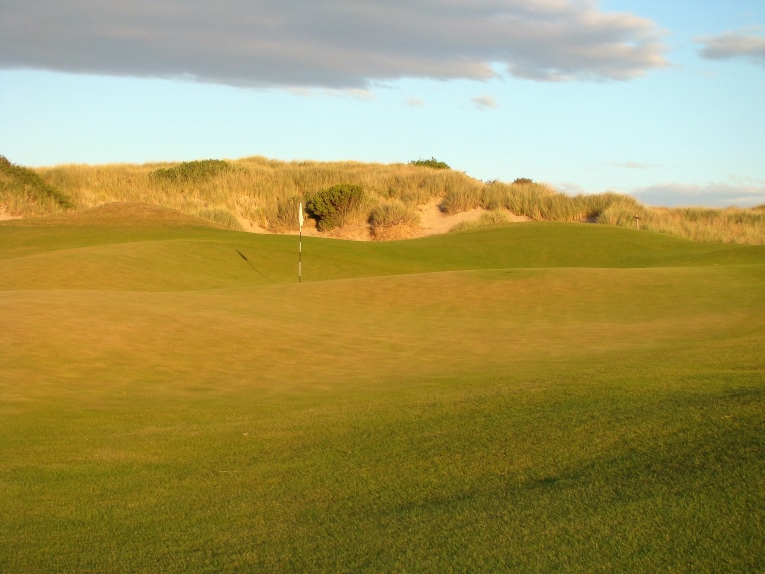
The card and pencil set that MacKenzie despised might not appreciate this back right hole location whereas the open-minded player might see it as a genuine chance for a kick-in birdie or even a hole-in-one.
Fourteenth hole, 510 metres; Large bunkers cut into natural up-slopes dominate the eye standing on the tee. There is no other visual quite like it on the course and the hole’s handsomeness carries it. Tillinghast loathed weak holes and the author imagines that he would be proud of how playing appeal was knocked into this one.
Fifteenth hole, 320 metres; Totally different than the third, fourth or twelfth, the final short two shotter features a long narrow green that poses a direct question: can he squeeze his tee ball between a central bunker and the dune right to gain a straightforward pitch down the length of the green? Having enjoyed such expansiveness off tees ten, eleven, and fourteen, the golfer might not be prepared to accept such a challenge (especially on a windy day). Many opt for caution, playing left of the central hazard which may lead to a blind approach over a dune to a green set at an awkward angle. Doak wasn’t always sold on the central bunker but Clayton fought hard for the Principal’s Nose feature which makes tangling with the hole several times in one trip a delight.
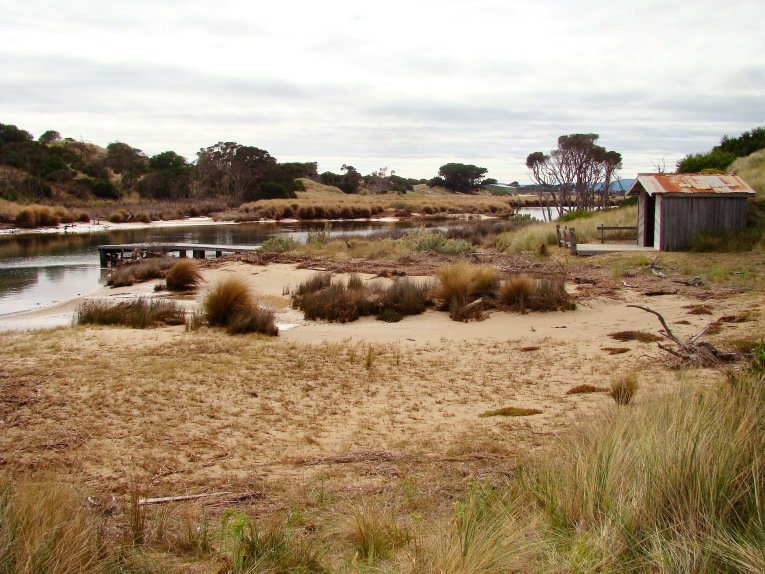
The fifteenth tee borders the Great Forester River where one senses the laconic pace of life that makes Tasmania special.
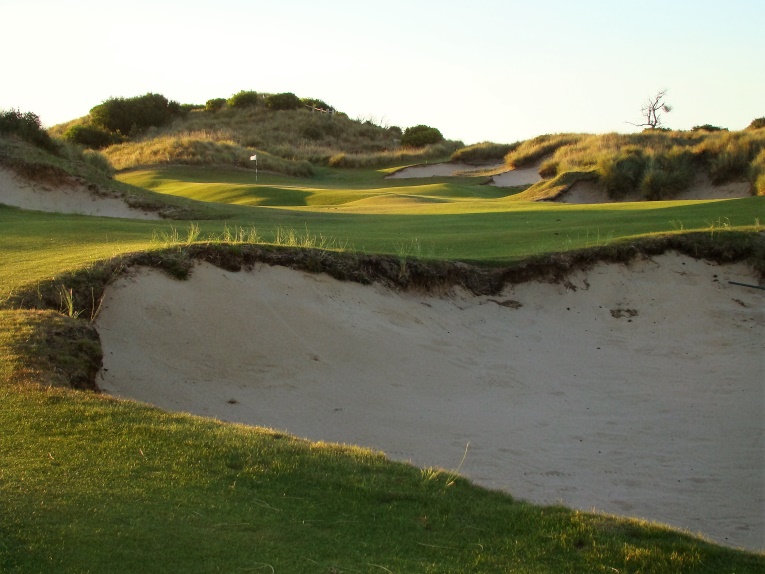
Life would be simpler if the architects hadn’t put this darn central bunker exactly where you want to place your tee ball.
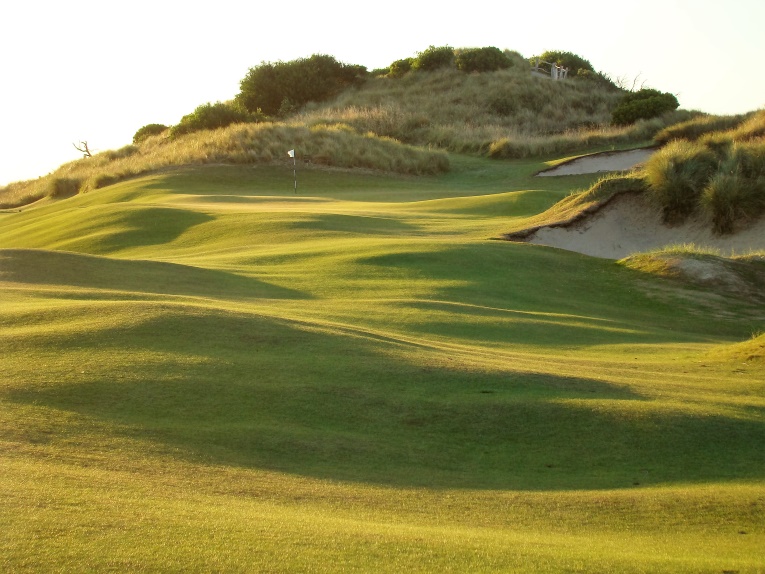
The brave man who fits his tee ball just right of it enjoys this appealing pitch down the length of the green whereas …
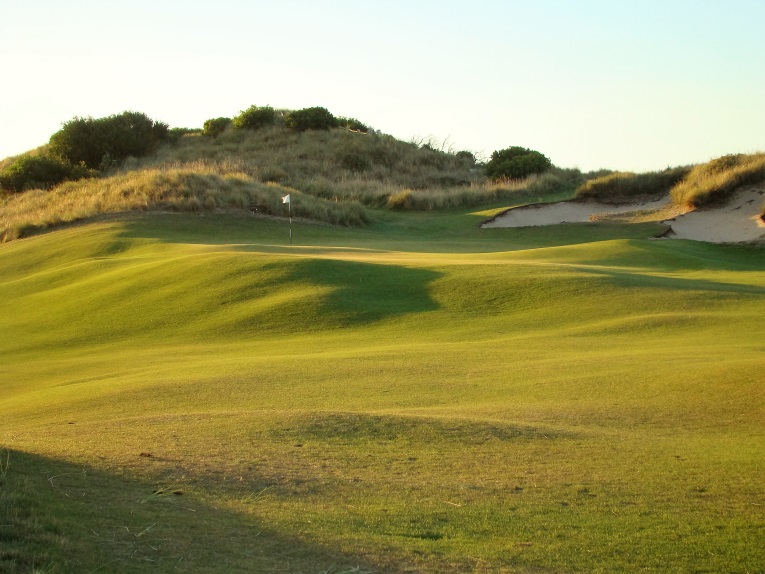
…those of us that play left must contend with the green’s steep left bank. The subtle terror of fescue manifests itself here as a missed approach won’t politely sit at the base of the green. No – it will be sent 10, 20 even 30 metres away – and then you really have a mess on your hands.
Sixteenth hole, 155 metres; When man began using heavy machinery more often in the 1970s and 1980s, the concept of perfect visuals was born. Tees were built up to give the golfer a clear sense – relentlessly so – of what to do from every tee box. It was all laid out before him. Of course, such a concept is anathema to those that love links golf. Variety trumps all. Just as Schneider went to great lengths to provide ideal optics of the putting surface for the uphill approach to the tenth, he endeavored to retain some mystery for the downhill shot to this one shotter. A bunker fifteen paces shy of the putting surface was built up just enough to hide the left front of the canted green. The old trooper delights in seeing his tee ball momentarily disappear from sight behind the bunker, only to re-emerge as it tracks along the ground – hopefully toward the hole. Judging how to play the slopes, especially when unseen from the tee, creates the hole’s elusive quality that is to be embraced, not shunned. Keiser himself suggested this hole, after Doak showed him the revised seventeenth.
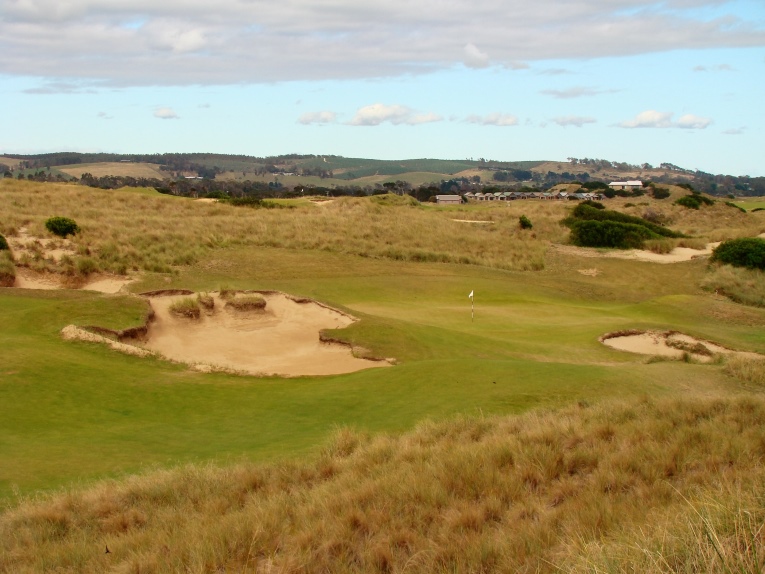
The bunker well in the foreground is just tall enough to obscure the green’s front left, which is often the ideal place to land one’s tee ball.
Seventeenth hole, 400 metres; One would think that more holes of this ilk would exist. As you play west down the coastline, a large sandy hazard emanates from the dunes on the direct line from tee to green. This deceptively simple extension of the dune into the fairway creates a strategically sound dogleg right. Yet, the author struggles to think of other examples of such coastal holes around the world, particularly in the United Kingdom. Usually the dune lines are maintained in a linear fashion but with just a little artistry, something much more engaging like the seventeenth could emerge.
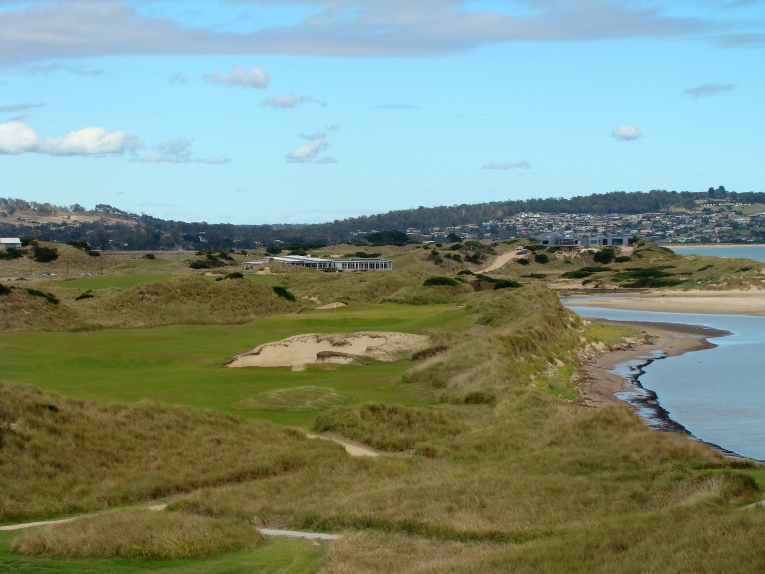
The penultimate hole would remain scenic (!) without the blowout fairway bunker but its playing interest would be considerably less if the straight playing corridor hadn’t been metamorphosed.

As seen from the left, much of the green pad is natural, the back right pocket between the dunes existed, and the ridge line along the left was present but taller. A foot or two of sand was cut from the ridge along the left to maximize the pinnable area of the front plateau. Minimalism at its finest!
Eighteenth hole, 405 metres; Rumpled land completes the picture. More than anything, this Home hole screams that golf at the highest level is about how the ball interacts with the land. The message doesn’t have to be any louder – or more cluttered – and the lack of fairway bunkers is a welcome show of restraint. Clayton notes with a wry smile that his favorite way to play at Barnbougle is when ‘you are not allowed to land any shot on the green (except the 7th where it is almost impossible). You must play running shots all the way – it’s so much fun. Kids now just pull out the rangefinder and take the club which flies the ball to where they want to land it – and they play the same way no matter the course. They never even visualize the easier shot with straighter faced club to pitch and run a ball onto the green. To see a long approach into 18 bound over the humps and bumps of the fairway and then swing right at the green is a shot of great beauty.’

This view back up the eighteenth fairway demonstrates that the right people worked on this property; what a shame/tragedy it would have been if these natural fairway contours had been lost to heavy handed construction methods.
The term ‘minimalism’ has been pulled and stretched by architects and publicists to the point where it has lost meaning. Indeed, plenty of ‘minimalist’ courses exist that are as awful as they are boring (i.e. more land needed to be moved to lend playing interest). Minimalism at its finest is undisturbed great land that yields great golf. A most fortuitous confluence of events – great land, talented designers and shapers that shared and exchanged ideas, and a wise owner that let them flourish – is what happened here.
Indeed, to the author, this course represents the pinnacle of minimalism in the Southern Hemisphere. A few to zero courses in the Northern Hemisphere might rival the design for a global distinction. Regardless, the result is one of those dozen or so places world-wide where there is nowhere else that the golfer would rather be: the golf – and nature – are just that compelling. A plane flight from all corners of the globe is emphatically worth it; otherwise, you might not appreciate just how great golf can be.
The End



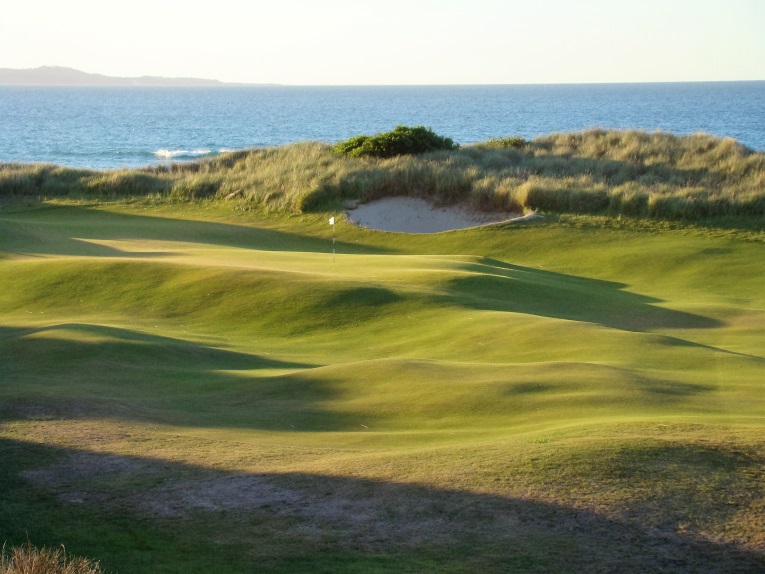
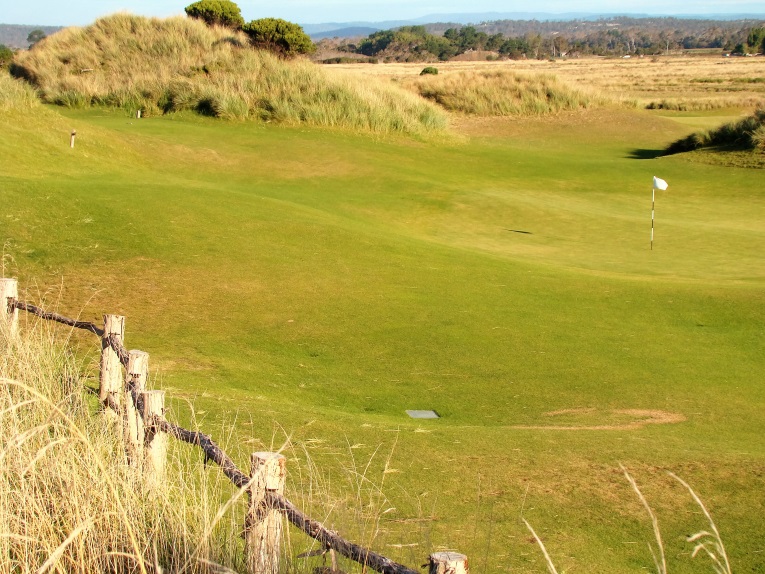
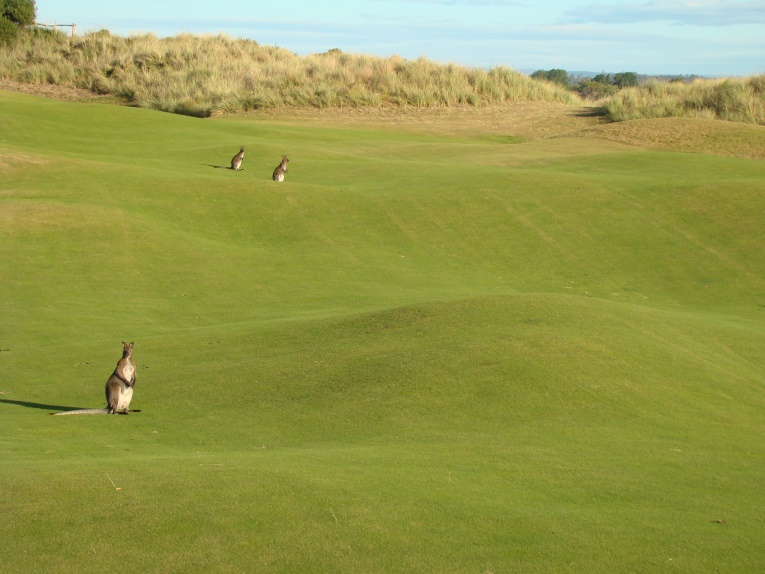
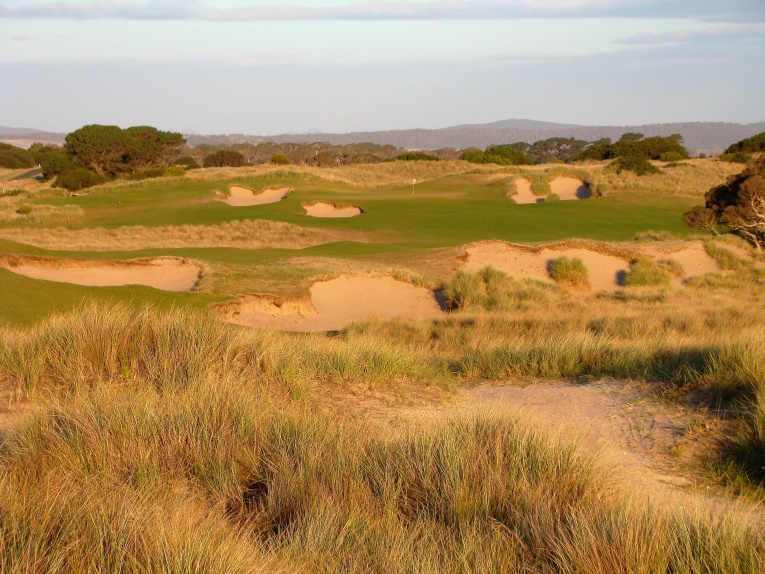
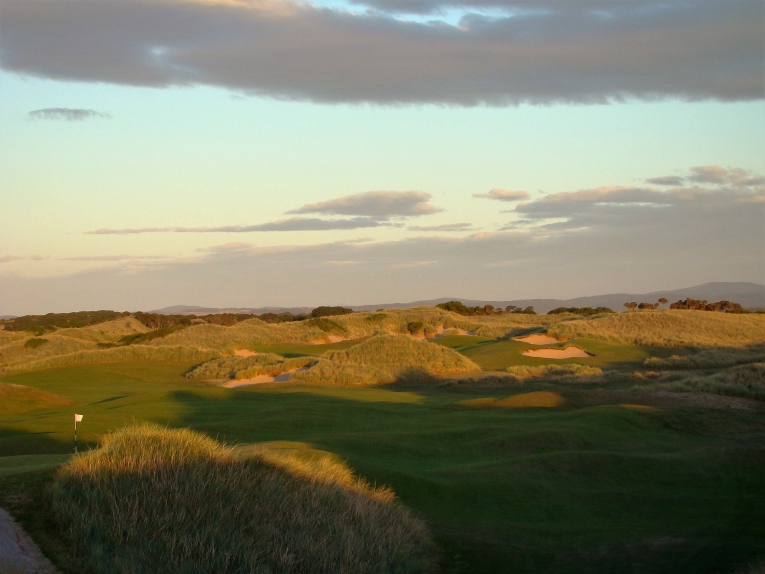

![Royal Melbourne (West) [2017]](https://golfclubatlas.com/wp-content/uploads/2016/03/RME16gb-500x383.jpg)

